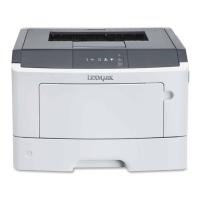Note: Some much smoother papers (such as premium 24 lb laser papers, 50–90 Sheeld units) and
much rougher papers (such as premium cotton papers, 200–300 Sheeld units) have been engineered
to work very well in laser printers, despite surface texture. Before using these types of paper, consult your
paper supplier.
• Suitable sheet-to-sheet coecient of friction (0.4–0.6)
•
Sucient
bending resistance in the direction of feed
Recycled paper, paper of lower weight (<60 g/m
2
[16 lb bond]) and/or lower caliper (<3.8 mils [0.1 mm]), and
paper that is cut grain-short for portrait (or short-edge) fed printers may have lower bending resistance than is
required for reliable paper feeding. Before using these types of paper for laser (electrophotographic) printing,
consult your paper supplier. Remember that these are general guidelines only and that paper meeting these
guidelines may still cause paper feeding problems in any laser printer (for example, if the paper curls excessively
under normal printing conditions).
Using specialty media
Tips on using card stock
Card stock is heavy, single‑ply specialty media. Many of its variable characteristics, such as moisture content,
thickness, and texture, can significantly impact print quality. Print samples on the card stock being considered
for use before buying large quantities.
When printing on card stock:
• Make sure the Paper Type is Card Stock.
• Select the appropriate Paper Texture setting.
• Be aware that preprinting, perforation, and creasing may significantly aect the print quality and cause jams
or other paper handling problems.
• Check with the manufacturer or vendor to ensure that the card stock can withstand temperatures up to
240°C (464°F) without releasing hazardous emissions.
• Do not use preprinted card stock manufactured with chemicals that may contaminate the printer. Preprinting
introduces semi‑liquid and volatile components into the printer.
• Use grain short card stock when possible.
Tips on using envelopes
Print samples on the envelopes being considered for use before buying large quantities.
• Use envelopes designed specifically for laser printers. Check with the manufacturer or vendor to ensure
that the envelopes can withstand temperatures up to 230°C (446°F) without sealing, wrinkling, curling
excessively, or releasing hazardous emissions.
•
For best performance, use envelopes made from 90‑g/m
2
(24‑lb bond) paper or 25% cotton. All‑cotton
envelopes must not exceed 70‑g/m
2
(20‑lb bond) weight.
• Use only new envelopes from undamaged packages.
• To optimize performance and minimize jams, do not use envelopes that:
– Have excessive curl or twist
– Are stuck together or damaged in any way
– Have windows, holes, perforations, cutouts, or embossing
– Have metal clasps, string ties, or folding bars
4514-2xx
General information
28

